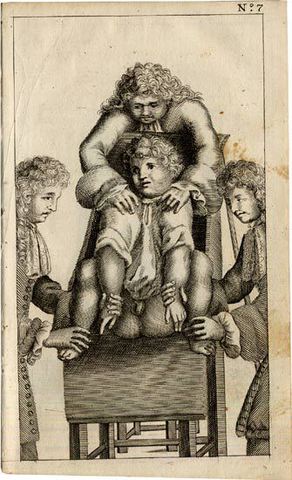TOLET, François (1647-1724)
Traité de la lithotomie, ou de l'extraction de la pierre, hors de la vessie; enrichy de figures necessaires pour representer la maniére de sonder, les instrumens propres, le malade dans l'operation: la ponction du perinée, & les differentes methodes de tirer la pierre : avec les appareils, les remedes preservatifs du calcul, & les medicamens pour les taillez. Dernière Édition.
La Haye, chez Barent Beek, 1686.














First published in Paris, 1681, this book appeared in several edition and translations. This may be a reprint of the third Paris edition of the same year. Francois Tolet was lithotomist at the Hôpital de Charité and is famous for his book on the extraction of the stone out of the bladder. It is of importance much due to the many superb engravings showing instruments, operation procedures, and especially for its examples of specialized surgery for children illustrating the difficulties of surgical techniques before the advent of anaesthetics. Vesical calculi were so common in France during the 16th and 17th centuries that kings appointed lithotomists to the court. In 1827 bladder stones were said to be frequent enough among Englismen 'to macadamise one side of Lincoln’s Inn Fields’. The condition, once so prevalent among adults, has almost completely disappeared in Europe.
Collation: Pp (14) lacking the engraved title (A1), 15-172, (6). With 18 engraved plates numbered 1-18, and two engravings in the text.
Binding: Rebound (ca. 1800) in blue paper boards.
Provenance: Carl Magnus Wennerdahl (1777–1809), surgeon at various hospitals, who died young by a cold; Pehr Anders Almqvist (1775–1817), Visingsö, town physician in Söderköping, spa doctor at Himmelstalund and provincial physician for Gotland's southern district. Many books from his library were donated to the Swedish Society of Medicine.
References: Murphy (ed.) History of Urology, pp 90-103; Wangensteen, pp 65-73; Krivatsy 11904; Hagelin, Rare and Important SLS, pp 82-83, Kiefer 570 (4th ed 1681) SLS 500. Waller 9626 - 9630 (other editions).